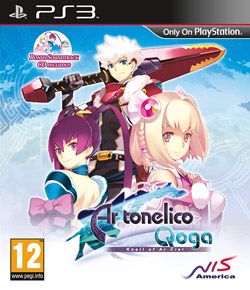Battle System
The battle system is real-time based, similar to those of the Star Ocean games. Only one Reyvateil can be present in battle. During a battle, the player controls one of three Vanguard (support/attacking) members and is able to switch control to another character at will. The non-player members of the party are controlled by AI. In battle, the player may attack enemies with an equipped weapon (with successive attacks resulting in a shot combo), protect the Reyvateil from enemy attacks by using a Blowback, or use the Song Magic of the Reyvateil. Items may be used to heal party members or damage enemies.
Additionally, the player can make the Reyvateil Purge (shed off part of her clothes) in order to increase the power of her Song Magic. To do this, the player has the attack the enemies whenever a red wave makes contact with the red line in the Harmograph located in the lower part of the screen. Doing this will trigger a Beat Up, which represents the heart of the Reyvateil becoming more excited upon seeing the party members fight hard for her. Once enough Beat Ups have been accumulated, a Purge Ready! notification will appear over the Heart Indicator located at the right of the Harmograph. When this happens, the player has to hold one of the shoulder buttons (L1, R1, R2 or L2) and shake the controller. If they did it correctly, the Reyvateil will Purge part of her clothes, the Burst Gauge will increase its charge speed, the Song Magic will level up to its next stage, and the party will gain an additional elemental attack and resistance depending on which button they held for executing the Purge (L1: Fire, L2: Wind, R1: Ice, R2: Lightning). However, if the Purge was performed incorrectly, the Reyvateil will refuse to Purge and the Song Magic will be released with less power than if it was used normally, so the player has to be careful.
Initially, Reyvateil Purge may only be used once; however, up to four levels of Purge and a multi-level Purge may be unlocked by advancing through the Cosmosphere of the Reyvateil. At the Reyvateil's fourth-level Purge, she will unleash her Song Magic Flipsphere, requiring the player to attack in sync with the pulsing of the Harmograph line. Depending on player execution, this results in additional or fewer attacks and may include a finishing blow.
Finally, some enemies can use powerful attacks that can hit the entire player party but require a charge time. When they are charging the attack, they will be surrounded by a blue barrier while a blue line appears on the Harmograph. During this time, the Burst Gauge is slowed down and Purging is disabled, so the player has to attack the enemy to break the barrier and nullify the attack. If they don't manage to do so before the blue line makes contact with the border of the Harmograph, the enemy will unleash the attack.
The Reyvateils are by themselves defenseless, so they must be defended by the player. Therefore, if all three Vanguard characters fall in battle (their HP reaches 0), the game is over, regardless of whether the Reyvateil is alive or not.
When an enemy enters the field surrounding the Reyvateil, an alarm will begin sounding as the HP of the Reyvateil begins being drained away while the Burst Gauge begins decreasing. As the Reyvateil can easily die in these conditions, the player can attack the enemy to get it away from her or activate the Blowback skill, which will teleport the player to the Reyvateil's side and execute a blow that will send the enemy to the opposite side of the battlefield. Once used, the Blowback skill must recharge.
RAH System
The acronym stands for "Real-time Active Hymmnetics", and it refers to the fact that the music used during battles, with the exception of the one used in some special events, is variable: each playable Reyvateil will begin singing at the start of battle a melody that will change depending on the actions taken by the player. Each Reyvateil has a base melody, but it can be modified by programming Hyumas into them. The Hyumas, aside of modifying the instrumentation, pitch, and rhythm of the melody, also grants bonuses to the party members when they are activated through the Purge System: periodical HP regeneration, resistance to status ailments, increases of attack and defense... such are what the Hyumas can do upon their activation. [3]
